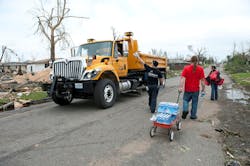What is your plan if a disaster strikes the area your business is located? What if one of your trucks is in the wrong place at the wrong time?
We all like to think we’re immune to disaster, but we’re not. We must have an action plan that can be implemented quickly. That plan must be shared with employees and contractors.
Disasters come in all shapes and sizes. It could be as small as a waterline break in the office that floods the filing room and drowns your computers, or could be something bigger such as a tornado, hurricane, flood or earthquake. Or, as we’ve recently seen, it could be due to civil unrest with Interstates blocked, loads ransacked and burned, and drivers placed in harm’s way. Each one of these scenarios requires preparation.
Whether a natural disaster or even a large-scale emergency like a health epidemic, there are a few necessary steps to assembling an emergency preparedness toolkit.
A disaster readiness kit is simply a collection of basic items your business office may need in the event of an emergency. If electricity is no longer available or tap water is not safe to drink, you will need alternatives. The kit should include items such as matches, bottled water, flashlights, batteries, and snacks for everyone who may be stranded at the office.
Homeland security recommends that you assemble your kit well in advance of an emergency. You may have to evacuate at a moment’s notice and take essentials with you.
You may need to survive on your own after an emergency. This means having everything you need in sufficient quantity for every person in the office. Local officials and relief workers will be on the scene after a disaster, but they cannot reach everyone immediately. You could get help in hours—or it might take days.
At least a three-day supply of non-perishable food should be stored. Choose foods your employees will eat and consider any special dietary needs. Also choose salt-free crackers, whole grain cereals and canned foods with high liquid content. Avoid foods that will make someone thirsty.
Additionally, basic services such as electricity, gas, water and sewer, and telephones may be cut off for days or longer. Your supply kit should contain items to help you manage during these outages.
Have a specific plan established for each type of disaster. For example, hurricanes, floods and wildfires usually offer plenty of warning, and evacuation is generally required—but often with limited time to gather what’s important. On the other hand, tornadoes, flash floods, and earthquakes happen with little or no warning and require a different plan to be prepared.
Here’s a list of ideas to get your company’s crisis communication plan started.
- Develop (and update) an emergency contact list that includes home phone numbers, mobile numbers, email addresses, family contact information, and a phone tree assignment system.
- Establish an evacuation plan and review it with employees on a regular basis.
- Create email and text alert systems that can provide multiple sources of ways to contact employees, contractors and customers. Test your system routinely.
- Implement an operating procedure for social networks to send out web-based crisis communications.
- Devise a plan to work with local media. You need to designate one or more contact person(s) and provide basic media training. All employees should know which members of the staff are media trained. Create key messaging points for these individuals to ensure consistent voice and information is released to the public.
- Monitor what is said and written about your company during and after a disaster. This provides insight on the strengths and weaknesses of your business strategy.
- Another part of your plan must be post-disaster. Preplanning and preparations are to protect the lives of you and your employees, along with vital equipment and files. The major post-disaster planning objective is to have your company up and running at full capacity as soon as possible.
- Are you carrying enough insurance?
- Do you have flood insurance?
- What does your policy cover and, more importantly, what doesn’t it cover?
- Do you have a recent evaluation of what your property and equipment is worth and what it would cost to replace it?
- What about any inventory?
- Do you have a safe place to store business documents?
- What is your back-up plan if that location is destroyed? How safe and reliable is your back-up location?
Keep in mind that many insurance policies do not cover damage from civil unrest, so have an alternate plan to cover those losses. One alternative is an SBA disaster assistance loan, or if the event is declared a Federal Disaster, FEMA disaster assistance may be available.
And don’t forget your truckers on the road. They are an extension of your office and each needs to have a disaster plan as outlined above. So as you put your plan together for your office, don’t forget a corresponding plan for your drivers.
Be safe year round by thinking, developing and fine-tuning your disaster preparedness plan once a month. Every quarter, have a disaster preparedness meeting to ensure all employees and contractors are up to speed.
All safety comes through good planning.
